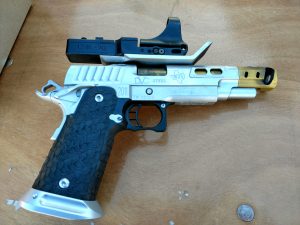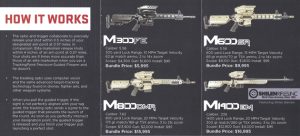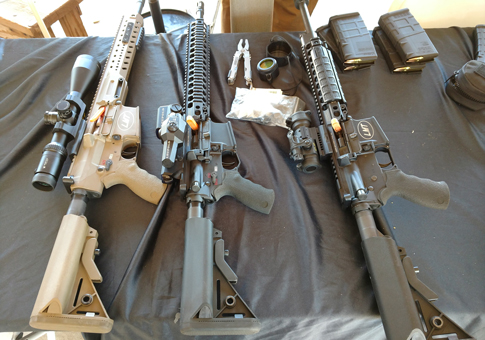It was 9:08 a.m. and our bus was stuck in the desert sands of Boulder City, Nevada. We'd veered down a closed road and were still about a mile from the site of SHOT Show 2017's Industry Day at the Range. This was a problem for me since I planned on shooting all the guns there. Given that over 200 manufacturers were exhibiting their products and the range was only open for 8 hours, it was already a hard enough task. Now I was half an hour behind schedule.
So, I hitched a ride up to the range, signed my waiver, and walked in. I immediately regretted not bringing my own hearing protection as the only option available were basic in-ear foamies—not ideal for the amount of shooting I was about to engage in, as I found out the next day.
Things started off well, though. The Glock booth was right at the entrance and its representatives were more than happy to let me shoot all their guns. The Springfield Armory booth was to the left and its reps also let me test out all of their offerings. To the left of it was the Rock Island Armory booth; I tried out all its guns, too. In the exhausting but exhilarating seven hours that followed, I shot around 100 firearms and 1,000 rounds of ammunition.
What do you learn from shooting that many guns in that short a period of time?
First off, industry trends become very apparent. Ten-millimeter was big this year. I'd never shot one before, but I must've shot five or six of them at range day. Semi-automatic handguns with barrels over six inches long are, apparently, no longer an oddity. Silencers were everywhere. And I mean everywhere.
Shooting all those silenced guns makes you wonder about the point of our current laws. When silencers were included in the National Firearms Act in the 1930s, it was pretty clear that the $200 tax stamp and registration paperwork were intended to prevent all but the richest Americans from purchasing them. But after 80 years, the $200 tax stamp is less of a burden for most Americans. Silencers are popular among law-abiding gun owners throughout the country—they're plentiful.
What exactly is the point of our current regulations, then? What purpose do they serve outside of annoying gun owners and drowning the ATF in paperwork? What does charging somebody $200 in taxes and making them wait several months for the ATF to process their application actually accomplish?

In recognizing industry trends, you also recognize manufacturers that are doing things a bit differently, like the single-action revolvers from EMF, the high-performance competition guns from STI, and the bullpups from Kel Tec. The most interesting among that group are probably the futuristic guns from TrackingPoint. There were many beautiful and capable precision firearms on the long-distance range—including an especially impressive offering from the Canadians at Prairie Gun Works—but there was only one that ensured a perfect shot with every pull of the trigger.
Shooting the TrackingPoint M1400EM is one hell of an experience. First you line the target up in the custom-computerized scope, pull the trigger halfway, and mark exactly where on the target you want to hit. Then, as you pull the trigger fully rearward, you have to line up your crosshairs with the electronic mark you just left on the target. Once the computerized scope determines you've lined up the two points perfectly, it drops the hammer and fires the round.
I hit every shot I took with the M1400EM at over 950 yards in windy conditions. It was easy. The gun pretty much does all the shooting for you. I was able to make the same 950-plus-yard shots with the Prairie Gun Works Timberwolf, although I had to hold my crosshairs high and to the left of the target.
The M1400EM's only drawback is that the delayed shot makes it basically impossible to brace for the recoil. When you're dealing with a .338 Lapua round whose muzzle concussion alone is enough to make pieces of the range's foam roof crumble to the ground, well, let's just say not being in complete control of when the round goes off can be jarring.

The experience also made me wonder where TrackingPoint technology fits into the shooting world. The gun is probably not best suited for military sniper teams, and it has already been deemed unfair for competitions. But what makes it unfair for competitions—the fact that anybody can consistently hit targets using it—might make it useful for instantly turning novices into marksmen. On the other hand, the time between setting the marker and matching up the crosshairs with it means the gun is ill-suited for any fast-paced environment. Either way, it was still the most interesting thing I shot.
It was not, however, the most fun. That honor is reserved, as usual, for the full-auto offerings. CMMG's unnatural but delightful AR/AK mashup—the aptly named Mutant—was a real kick-in full-auto. The full-sized, full-auto rifles equipped with silencers were a joy to shoot sans ear plugs.
Personally, though, I'm a sucker for the sound and fury of a short-barreled, full-auto rifle. Ever since I first shot "The Little Ass Kicker" I've been addicted to full-auto SBRs. Thankfully, Industry Day at the Range had plenty of those to satiate my cravings. I was even lucky enough to be the last person of the day to shoot the Kriss Vector, which is noticeably smoother than other SBRs but without sacrificing the raggedy edge that makes the experience so divine.
As I caught the last bus back to Vegas, I thought to myself, "Today was a good day."
